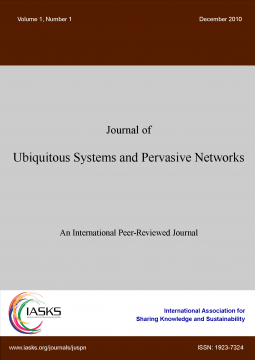volume-05-Issue 2 (2014)
Latest Articles
Privacy Management Solution in Ubiquitous Environments Using Percontrol
JUSPN, volume-05, Issue 2 (2014) , PP 21 - 28
Published: 29 Apr 2014
DOI: 10.5383/JUSPN.05.02.004
by Valderi R. Q. Leithardt, David Nunes, Anubis G. M. Rossetto, Carlos O. Rolim, Cláudio F. R. Geyer, Jorge Sá Silva from Federal University of Rio Grande do Sul - Institute of Informatics – GPPD - Porto Alegre, RS - Brazil University of Coimbra Department of Informatics Engineering Pólo II, Pinhal de Marrocos, Coimbra - Portugal
Abstract: The identification of users in pervasive and ubiquitous environments can be performed using various devices and techniques, among which the use of wireless sensor networks (WSN), radio frequency identifiers (RFID), Smartphones, Bluetooth, among others. However, it is necessary to implement management techniques and control privacy of these heterogeneous environments. Thus, we performed a study using artificial neural networks in order to perform the processing of information identified only generating an output of information to Percontrol. read more... read less...
Keywords: Pervasive Computing, Routing, Wireless Sensor Networks, Artificial Neural Networks.
A Micro Simulated and Demand Driven Supply Chain Model To Estimate Regional Production and Consumption Relations
JUSPN, volume-05, Issue 2 (2014) , PP 16 - 20
Published: 17 Apr 2014
DOI: 10.5383/JUSPN.05.02.003
by Omar Abed, Tom Bellemans, Gerrit K. Janssens, Ansar Yasar, Davy Janssens, Geert Wets from Transportation Research Institute (IMOB),Hasselt University, Wetenschapspark 5 box 6, B-3590 Diepenbeek, Belgium Research group Logistics, Hasselt University, Agoralaan Gebouw D, B-3590 Diepenbeek, Belgium
Abstract: The various operations of production, distribution and consumption of goods make up supply chain networks. The usual pre requisite to model freight flows on between geographical zones, is an understanding of intra zonal production and consumption relations. This is in essence an aggregation of all individual firm to firm interactions taking place in form of production and consumption of goods, as well as transportation firms involved in the goods exchange process. In this paper, a demand driven micro-simulated supply chain model is presented. The presented model is a microsimulation model modeling the main firm types present in a traditional supply chain. It is a demand driven model using quantity of goods requested at the consumer side as a starting point. The different interacting firms use a modified Economic Order Quantity (EOQ) model as the basis of the simulation process. The cost function used includes also transportation and labor costs. The model simulates also shipping and carrying firms and takes into account raw material suppliers able to supply all or some subcomponents needed by production firms. Different initial conditions can be used to mimic real life firm to firm interactions. Firm level and zone level scenarios are simulated and results are shown. read more... read less...
Keywords: supply chain microsimulation, production-consumption tables, optimized location choice
Simulation of Carpooling Agents with the Janus Platform
JUSPN, volume-05, Issue 2 (2014) , PP 09 - 15
Published: 17 Apr 2014
DOI: 10.5383/JUSPN.05.02.002
by Stéphane Galland, Ansar-Ul-Haque Yasar, Luk Knapen, Nicolas Gaud, Tom Bellemans, Davy Janssens from Multiagent Group, IRTES-SET, UTBM, 90010 Belfort cedex, France Transportation Research Institute (IMOB), Hasselt University, Belgium
Abstract: Carpooling is an emerging alternative transportation mode that is eco-friendly and sustainable as it enables commuters to save time, travel resource, reduce emission and traffic congestion. The procedure of carpooling consists of a number of steps namely; (i) create a motive to carpool, (ii) communicate this motive with other agents, (iii) negotiate a plan with the interested agents, (iv) execute the agreed plans, and (v) provide a feedback to all concerned agents. The state-of-the-art research work on agent-based modeling is limited to a number of technical and empirical studies that are unable to handle the complex agent behavior in terms of coordination, communication and negotiations. In this paper, we present a conceptual design of an agent-based model (ABM) for the carpooling a that serves as a proof of concept. Our model for the carpooling application is a computational model that is used for simulating the interactions of autonomous agents and to analyze the effects of change in factors related to the infrastructure, behavior and cost. In our carpooling application, we use agent profiles and social networks to initiate our agent communication model and then employ a route matching algorithm, and a utility function to trigger the negotiation process between agents. We plan to, as a part of the future work, develop a prototype of our agent-based carpooling application based on the work presented in this paper. Furthermore, we also intend to carry out a validation study of our results with real data. read more... read less...
Keywords: Carpooling Problem, Multi-agent simulation, Organizational Model, Janus Platform

